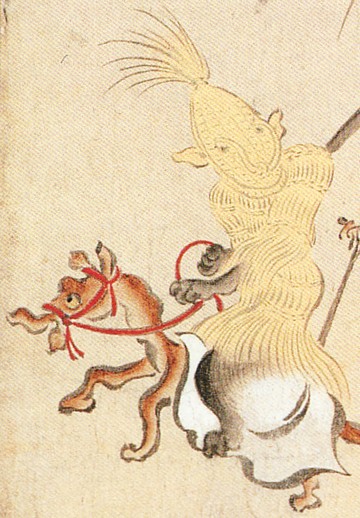
Last weekend, I stayed home and watched the late night Japanese variety show. When drinking alone, I liked to set up half a dozen choko (saké cups) and fill them to the brim. Everytime I laughed, I chugged a cup and then overturned the choko. Once all the choko are empty, I reset and refilled the sake. I drank so much that I slept at the table. Later that night, I awoke to clattering. And then, I saw my upturned choko moving across the floor. Surely, I had seen a chokuboron. But it was going everywhere and nowhere. It just wandered everywhere aimlessly.

Chokuboron is a type of yokai known as tsukumogami. They evolved from 100-year old saké cups known as choko. Especially, those used as offerings to the dead. After evolution, chokuboron adopted a behaviour similar to the vagabond. As such, they wandered around like lost melancholic souls.
Appearance
Consequently, chokuboron is called as such because the looked like komusō (虚無僧), the travelling monks. Instead of a full face straw hat (tengai), the tsukumogami wears a choko on its head. Although fully covered, they are able to move around easily. Also, chokuboron play traditional bamboo flutes called shakuhachi. They play haunting songs that evoke fear. Melodies of nightmares.
But, unlike most yokai, chokuboron is a very small yokai. It is as tall as a typical coffee mug. Even then, they wore small monk attire and straw sandals. Interestingly, when you looked at them they moved ever so slowly and deliberately. But once you blinked, the chokuboron would have move a great distance whence you last saw it. Intriguing, but at the same time, terrifying.
Conclusion
As such, chokuboron are difficult to find. They treasure their vagabond spirit. They have been seen all across Japan, from a small bar at Kabuchiko to a shrine on Mount Asahi (旭岳). But none have been caught. All eyewitness accounts describe their erratic movements. Although, Chokuboron are inherently harmless, by all accounts. But, do they really wander everywhere aimlessly? Or are we too oblivious to understand?
Yokai Details
- name: chokuboron ( cho-koo-boh-ron )
- kanji: 船幽霊 (ちょくぼろん)
- meaning: cup monk
- abilities:
- unseen speed — when unobserved, it moves extremely fast
- death song — plays melody that relieve your death experiences
















